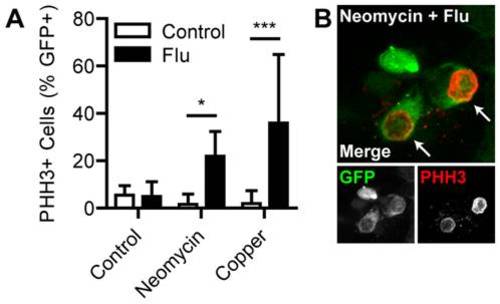- Title
-
Proliferative regeneration of zebrafish lateral line hair cells after different ototoxic insults
- Authors
- Mackenzie, S.M., and Raible, D.W.
- Source
- Full text @ PLoS One
|
Hair cells are derived from proliferating progenitors. (A) Wild type larvae were treated at 5 dpf with neomycin or copper for 1 h followed by recovery in 5 mM BrdU until 24 hpt followed by fresh embryo medium. Greater numbers of BrdU-positive hair cells were observed in all ototoxin-treated groups at 72 hpt. (B) One-way ANOVA followed by a Tukey post-hoc analysis of the proportion of BrdU-positive hair cells revealed significant increases in all ototoxin-treated groups compared to control (p<0.001). No significant difference was observed between 1 and 10 μM copper that would suggest a dose-dependent effect on proliferative regeneration. A small but significant difference was observed between neomycin and 1 μM copper (*, p<0.05). N = 8 fish per group. Error bars are + SD. (C) Example neuromast at 72 hpt from a fish treated with 1 μM copper. Arrows mark BrdU-positive hair cells. |
|
Flubendazole impairs division of hair cell progenitors. ET4:GFP larvae were treated at 5 dpf with neomycin or copper for 1 h and incubated in flubendazole for 24 h. Immunohistochemistry was performed for GFP and PHH3, which is upregulated during mitosis. (A) Two-way ANOVA followed by Bonferroni post-hoc analysis found significant increases in the proportion of PHH3-positive cells in neomycin- and copper-treated larvae when treated with flubendazole (*, p<0.05; ***, p<0.001), demonstrating that cell division was arrested in GFP-positive hair cell precursors. N = 8 fish per group. Error bars are + SD. (B) Example neuromast at 24 hpt from a fish treated with neomycin and flubendazole. Arrows mark PHH3-positive nuclei. |


